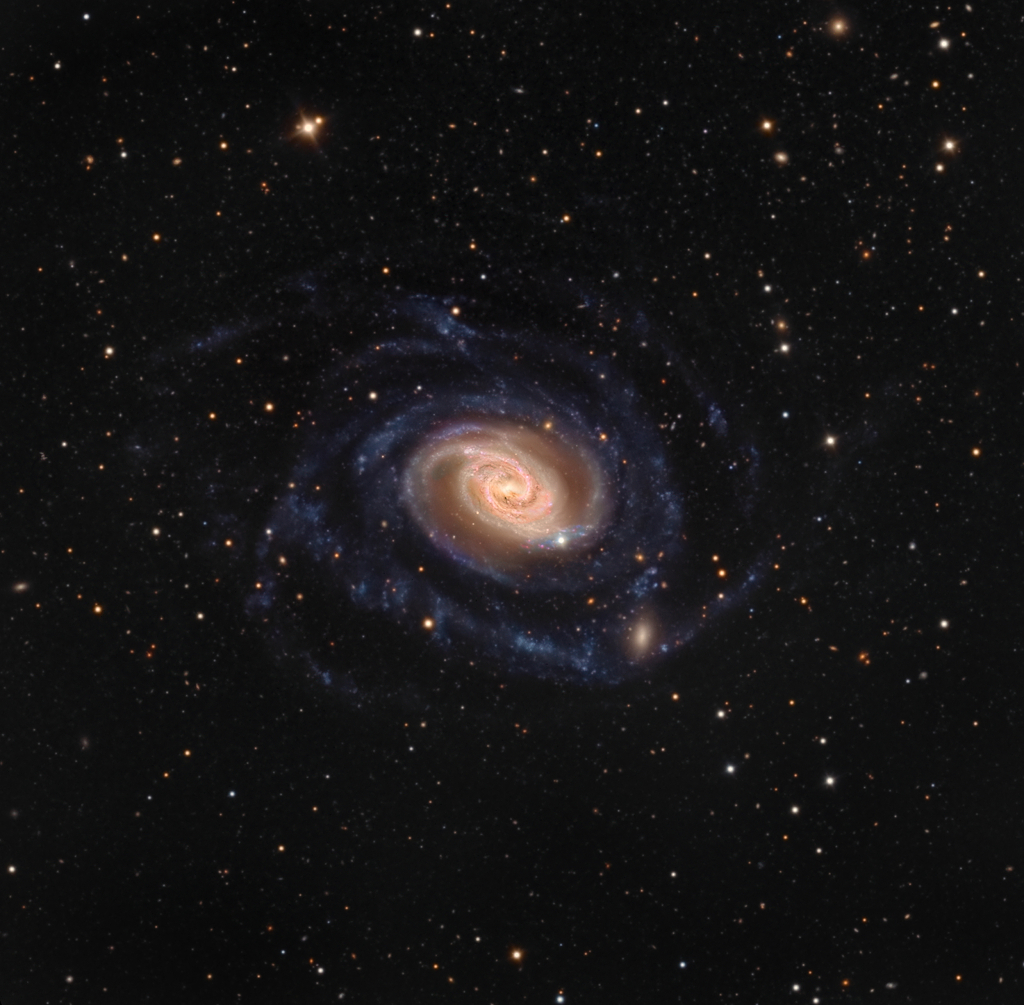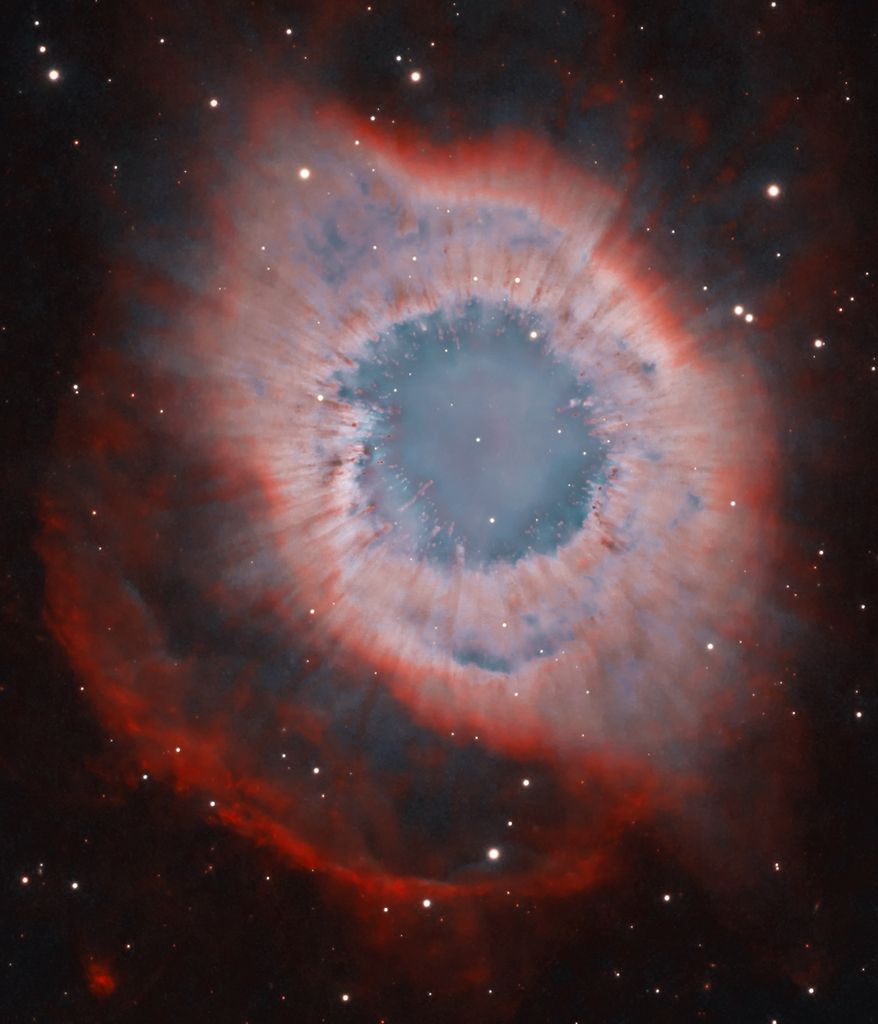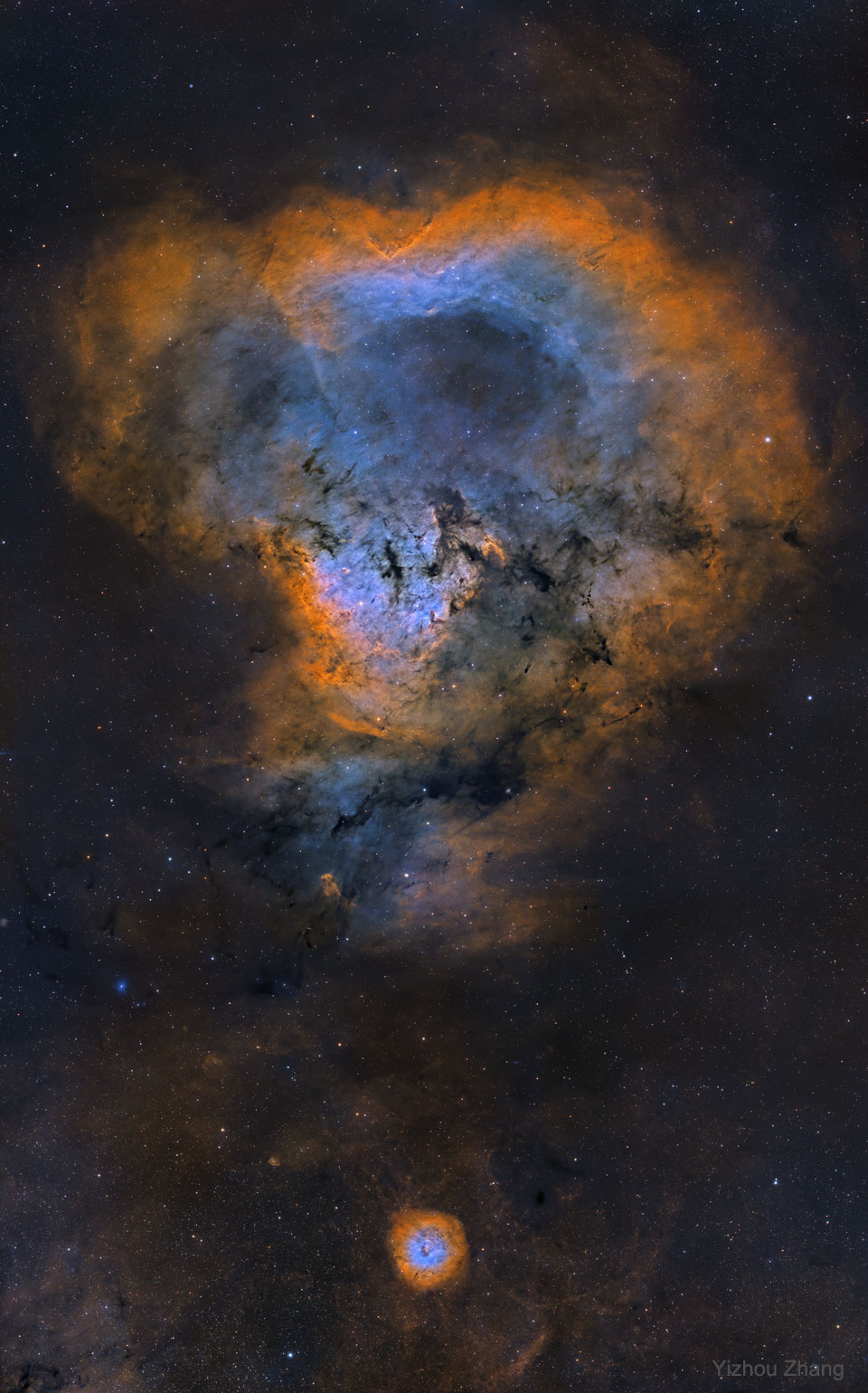Blog
Performing tonight for Shabbat for the Soul with Kim Salisbury
more...About 70 million light-years distant, gorgeous spiral galaxy NGC 289 is larger than our own Milky Way. Seen nearly face-on, its bright core and colorful central disk give way to remarkably faint, bluish spiral arms. The extensive arms sweep well over 100 thousand light-years from the galaxy’s center. At the lower right in this sharp, telescopic galaxy portrait the main spiral arm seems to encounter a small, fuzzy elliptical companion galaxy interacting with enormous NGC 289. Of course spiky stars are in the foreground of the scene. They lie within the Milky Way toward the southern constellation Sculptor.

Fela Aníkúlápó Kuti (born Olufela Olusegun Oludotun Ransome-Kuti; 15 October 1938 – 2 August 1997) also known as Abami Eda was a Nigerian multi-instrumentalist, bandleader, composer, political activist, and Pan-Africanist. He is regarded as the pioneer of Afrobeat, an African musicgenre that combines traditional Yoruba percussion and vocal styles with American funk and jazz. At the height of his popularity, he was referred to as one of Africa‘s most “challenging and charismatic music performers”. AllMusic described him as a “musical and sociopolitical voice” of international significance.
Kuti was the son of a Nigerian women’s rights activist, Funmilayo Ransome-Kuti. After early experiences abroad, he and his band Africa 70 (featuring drummer Tony Allen) shot to stardom in Nigeria during the 1970s, during which he was an outspoken critic and target of Nigeria’s military juntas. In 1970, he founded the Kalakuta Republic commune, which declared itself independent from military rule. The commune was destroyed in a 1978 raid. Since his death in 1997, reissues and compilations of his music have been overseen by his son, Femi Kuti.
Olufela Olusegun Oludotun Ransome-Kuti was born into the Ransome-Kuti family, an upper-middle-class Nigerian family, on 15 October 1938 in Abeokuta (the modern-day capital of Ogun State), which at the time was a city in the British Colony of Nigeria. His mother, Chief Funmilayo Ransome-Kuti, was an anti-colonial feminist, and his father, Reverend Israel Oludotun Ransome-Kuti, was an Anglican minister, school principal, and the first president of the Nigeria Union of Teachers. His brothers Beko Ransome-Kuti and Olikoye Ransome-Kuti, both medical doctors, were well known nationally. Kuti was a first cousin once removed to the writer and Nobel laureate Wole Soyinka, the first black African to win the Nobel Prize for Literature, as they are both descendants of Josiah Ransome-Kuti, who is Kuti’s paternal grandfather and Soyinka’s maternal great-grandfather.
more...Lionel Frederick Cole (October 15, 1931 – June 27, 2020) was an American jazz singer and pianist whose recording career spanned almost 70 years. He was the brother of musicians Nat King Cole, Eddie Cole, and Ike Cole, father of Lionel Cole, and uncle of Natalie Cole and Carole Cole.
Freddy Cole was born to Rev. Edward J. Coles and Perlina (Adams) Coles, and grew up in Chicago, Illinois. His brothers Nat King Cole (1919–1965), Eddie (1910–1970), and Ike (1927–2001) also each pursued careers in music. He began playing piano at the age of six, and continued his musical education at the Roosevelt Institute in Chicago. He moved to New York in 1951, where he studied at the Juilliard School of Music before completing a master’s degree at the New England Conservatory of Music.
more...Dr. Natesan Ramani (15 October 1934 – 9 October 2015), commonly known as N. Ramani or N. Flute Ramani, was an Indian Carnatic flautist. He was awarded the Madras Music Academy‘s Sangeetha Kalanidhi in 1996. Ramani is also credited with introducing the long flute into Carnatic music.
Ramani was born in Tiruvarur, a city in Tamil Nadu which is honored by its association with the Trinity of Carnatic music. Ramani was born into a family of flautists. Ramani first learnt music from his grandfather, Sri Aazhiyur Narayanaswami Iyer, a well known flute artist and singer himself.Aware of young Ramani’s keen interest in the Carnatic flute, Ramani’s initiation to Carnatic music began at the age of five.
Ramani performed his first concert at the age of 8. The turning point in Ramani’s career was when he became a disciple of his maternal uncle and eminent flautist, the late T. R. Mahalingam (known more commonly as “Flute Mali”), who first popularised the Carnatic flute in Indian music. By the age of 11 years, his first concert was held at Singaravelavar Temple, Sikkil, near Nagapattinam, Tamil Nadu. His mother Smt Sarathambal was instrumental in bringing him to notice. She accompanied him for his concerts when he was studying at Boys High School Tiruvarur. Ramani accompanied his guru T. R. Mahalingam in a concert for the first time. N Ramani is related to Sikkil Sisters, his contemporary flute-playing duo.
more...MacHouston “Mickey” Baker (October 15, 1925 – November 27, 2012) was an American guitarist, best known for his work as a studio musician and as part of the recording duo Mickey & Sylvia.
Baker was born in Louisville, Kentucky. His mother was black, and his father, whom he never met, was believed to be white.
In 1936, at the age of 11, Baker was put into an orphanage. He ran away frequently, and had to be retrieved by the staff from St. Louis, New York City, Chicago, and Pittsburgh. Eventually the orphanage quit looking for him, and at the age of 16 he stayed in New York City. He found work as a laborer and then a dishwasher. But after hanging out in the pool halls of 26th Street, he gave up work to become a full-time pool shark.
more...Victoria Regina Spivey (October 15, 1906 – October 3, 1976), sometimes known as Queen Victoria, was an American blues singer and songwriter. During a recording career that spanned 40 years, from 1926 to the mid-1960s, she worked with Louis Armstrong, King Oliver, Clarence Williams, Luis Russell, Lonnie Johnson, and Bob Dylan. She also performed in vaudeville and clubs, sometimes with her sister Addie “Sweet Peas” (or “Sweet Pease”) Spivey (August 22, 1910 – 1943), also known as the Za Zu Girl. Among her compositions are “Black Snake Blues” (1926), “Dope Head Blues” (1927), and “Organ Grinder Blues” (1928). In 1962 she co-founded Spivey Records.
Born in Houston, Texas, she was the daughter of Grant and Addie (Smith) Spivey. Her father was a part-time musician and a flagman for the railroad; her mother was a nurse. She had two sisters, both of whom also sang professionally: Addie “Sweet Peas” (or “Sweet Pease”) Spivey (August 22, 1910 – 1943), who recorded for several major record labels between 1929 and 1937, and Elton Island Spivey Harris (1900–1971).
more...Soleares is often referred to as the mother of all flamenco forms because so many other important forms are derived from it. It may be more accurate to think of soleares as the most flamenco of flamenco forms. All the elements of soleares, including its 12-count compás with an irregular beat structure, its Andalusian cadence, and its melodic and melissmatic gestures are unique to flamenco. Soleares first evolved in the late 18th Century from a dance form called Jaleo. As it evolved through the 19th Century, it took on a more solemn, cante jondo character, probably due to its inclusion in the Cafés Cantantes as a featured song and flamenco dance. Various forms of soleares developed associated with different cities and individuals. At the beginning of the 20th Century new forms were derived from soleares, including bulerías and soleá por bulerías. A common belief is that the word soleares is derived from the Spanish word soledad, or sorrow. Sorrowful, unrequited love is a main theme of the letras, along with other bittersweet lamentations.
more...A mere seven hundred light years from Earth, toward the constellation Aquarius, a sun-like star is dying. Its last few thousand years have produced the Helix Nebula (NGC 7293), a well studied and nearby example of a Planetary Nebula, typical of this final phase of stellar evolution. A total of 90 hours of exposure time have gone in to creating this expansive view of the nebula. Combining narrow band image data from emission lines of hydrogen atoms in red and oxygen atoms in blue-green hues, it shows remarkable details of the Helix’s brighter inner region about 3 light-years across. The white dot at the Helix’s center is this Planetary Nebula’s hot, central star. A simple looking nebula at first glance, the Helix is now understood to have a surprisingly complex geometry.

Justin David Hayward (born 14 October 1946, in Swindon, Wiltshire) is an English musician best known as songwriter, lead singer, and guitarist of the rock band The Moody Blues. Hayward became the group’s principal lead guitarist and vocalist over the 1967–1974 period, and the most prolific songwriter and composer of several international hit singles for the band.
Hayward wrote singles for the Moody Blues including “Nights in White Satin“, “Tuesday Afternoon“, “Voices in the Sky“, “Never Comes the Day“, “Question“, “The Story in Your Eyes“, “Driftwood“, “The Voice“, “Blue World“, “Your Wildest Dreams“, “I Know You’re Out There Somewhere” and “English Sunset“; in all, writing 20 of the group’s 27 post-1967 singles. He also has a solo career. His first album outside the Moody Blues, Blue Jays, a collaboration with John Lodge, reached the UK top five in 1975. The single “Blue Guitar”, recorded with 10cc as the backing band, reached the UK top ten in 1975, and his 1978 recording of “Forever Autumn” from Jeff Wayne’s Musical Version of The War of the Worlds reached the UK top five. In 2018, Hayward was inducted into the Rock and Roll Hall of Fame as a member of the Moody Blues.
more...Pandit Nikhil Ranjan Banerjee (14 October 1931 – 27 January 1986) was an Indian classical sitarist of the Maihar Gharana. A student of the legendary Baba Allauddin Khan, Pandit Nikhil Banerjee was known for his technical virtuosity and clinical execution. Along with Pandit Ravi Shankarand Ustad Vilayat Khan, he emerged as one of the leading exponents of the sitar. He was a recipient of the Indian civilian honour of the Padma Bhushan.
Nikhil Banerjee was born on 14 October 1931 in a Bengali Brahmin family, in Calcutta. His father, Jitendranath Banerjee, was an amateur sitarist and Banerjee was fascinated by his father’s playing. Although he wanted to try his hand at an instrument as early as the age of four, he was discouraged by his father and grandfather. At the age of five, however, they relented and he acquired a small sitar, initially learning under his father. Banerjee grew into a child prodigy. He won an all-India sitar competition and became the youngest musician employed by All India Radioat the age of nine. Jitendranath approached Mushtaq Ali Khan to take Nikhil as a disciple, but only learned from this master for a few short weeks. Instead Birendra Kishore Roy Chowdhury, the zamindar of Gouripur in present-day Bangladesh, became responsible for much of his early training. He also had considerable training under Pt. Radhika Mohan Maitra, before he went under the discipleship of Ustd. Allauddin Khan.
more...Duško Gojković (Serbian Cyrillic: Душко Гојковић; born 14 October 1931) is a Bosnian jazz trumpeter, composer, and arranger.
Gojković was born in Jajce (ex-Yugoslavia, now in Bosnia-Herzegovina). He studied at the Belgrade Music Academy from 1948 to 1953. He played trumpet in dixieland bands and joined the big band of Radio Belgrade when he was eighteen. He moved to West Germany and first recorded as a member of the Frankfurt Allstars in 1956. He spent the next four years as a member of Kurt Edelhagen‘s orchestra.
In these years, Gojković played with Chet Baker, Stan Getz, and Oscar Pettiford. In 1958, he performed at Newport Jazz Festival and drew attention on both sides of the Atlantic Ocean. In 1961, Gojkovic received a scholarship to attend Berklee College of Music, where he studied with Herb Pomeroy
more...Robert Parker (October 14, 1930 – January 19, 2020) was an American R&B singer and musician, best known for his 1966 hit, “Barefootin’“.
Robert Parker, Jr. was born in Mobile, Alabama, United States, to Robert and Leana Parker. He grew up in New Orleans, Louisiana, and started his career as a saxophonist, playing with Professor Longhair on his hit “Mardi Gras In New Orleans” in 1949.
During the 1950s, Parker played alto and tenor saxophone with many of the most popular New Orleans performers, appearing on records by Eddie Bo, Huey “Piano” Smith, Earl King, James Booker, Ernie K-Doe, Tommy Ridgley, Fats Domino and others in New Orleans, and backed up visiting R & B artists including Solomon Burke, Lloyd Price, Jerry Butler and Otis Redding.
more...James “Son” Thomas (October 14, 1926 – June 26, 1993) was an American Delta blues musician, gravedigger and sculptor from Leland, Mississippi.
Thomas was born in Eden, Mississippi on October 14, 1926. While working in the fields, he began listening to blues on the radio. As a self-taught guitarist, he learned to play songs from older blues guitarists Elmore Davis and Arthur “Big Boy” Crudup. He then worked as a gravedigger in Washington County.
Thomas became known after appearing in films made by the Center for Southern Folklore in the 1970s. He appeared in the films Delta Blues Singer: James “Sonny Ford” Thomas, Give My Poor Heart Ease: Mississippi Delta Bluesmen, and Mississippi Delta Blues. In the 1970s, Eddie Cusic performed with Thomas at regular engagements. Together they recorded “Once I Had a Car”, which is included on the compilation album Mississippi Delta & South Tennessee Blues (1977). In the 1980s, Thomas recorded internationally.
more...At the edge of a giant molecular cloud toward the northern constellation Cepheus, the glowing star forming region NGC 7822 lies about 3,000 light-years away. Within the nebula, bright edges and dark shapes stand out in this colorful and detailed skyscape. The 9-panel mosaic, taken over 28 nights with a small telescope in Texas, includes data from narrowband filters, mapping emission from atomic oxygen, hydrogen, and sulfur into blue, green, and red hues. The emission line and color combination has become well-known as the Hubble palette. The atomic emission is powered by energetic radiation from the central hot stars. Their powerful winds and radiation sculpt and erode the denser pillar shapes and clear out a characteristic cavity light-years across the center of the natal cloud. Stars could still be forming inside the pillars by gravitational collapse but as the pillars are eroded away, any forming stars will ultimately be cut off from their reservoir of star stuff. This field of view spans over 40 light-years across at the estimated distance of NGC 7822.

More Posts
- Bernard Purdie Day
- Shelly Manne Day
- World Music with Orchestre National de Barbés
- Daily Roots with Bunny Wailer & Ruffi-Ann
- The Cosmos with NGC 6543
- Gary Thomas Day
- João Gilberto Day
- Howlin’ Wolf Day
- Chink Martin Day
- World Music with Samba Touré
- Daily Roots with Alpha & Omega
- The Cosmos with Abell 3827
- Kenny Barron Day
- Les Paul Day
- Cole Porter Day
- World Music with Zemari Zerfe Kebede
- Daily Roots with Scientist
- The Cosmos with NGC 346
- Boz Scaggs Day
- Bill Watrous Day